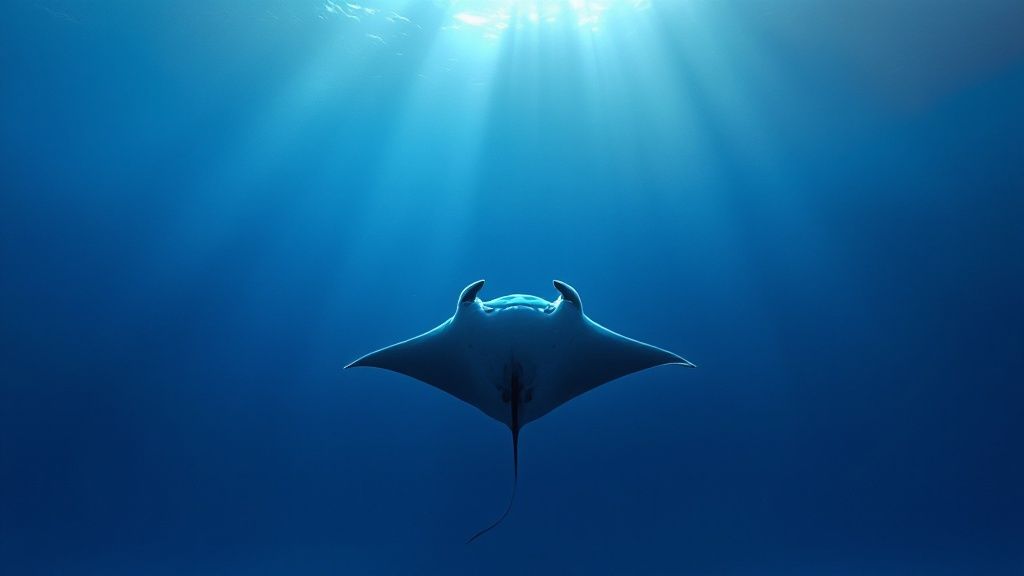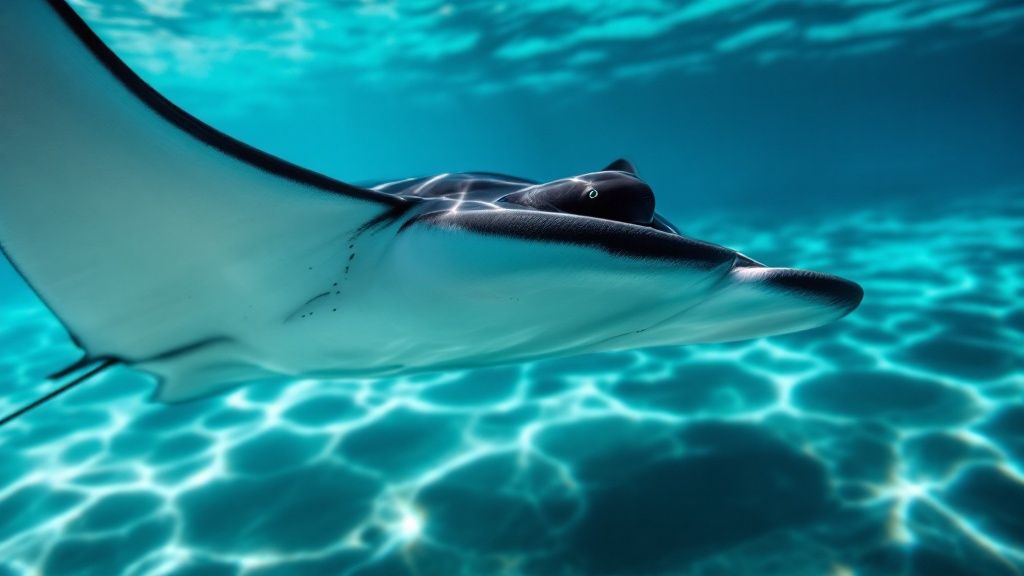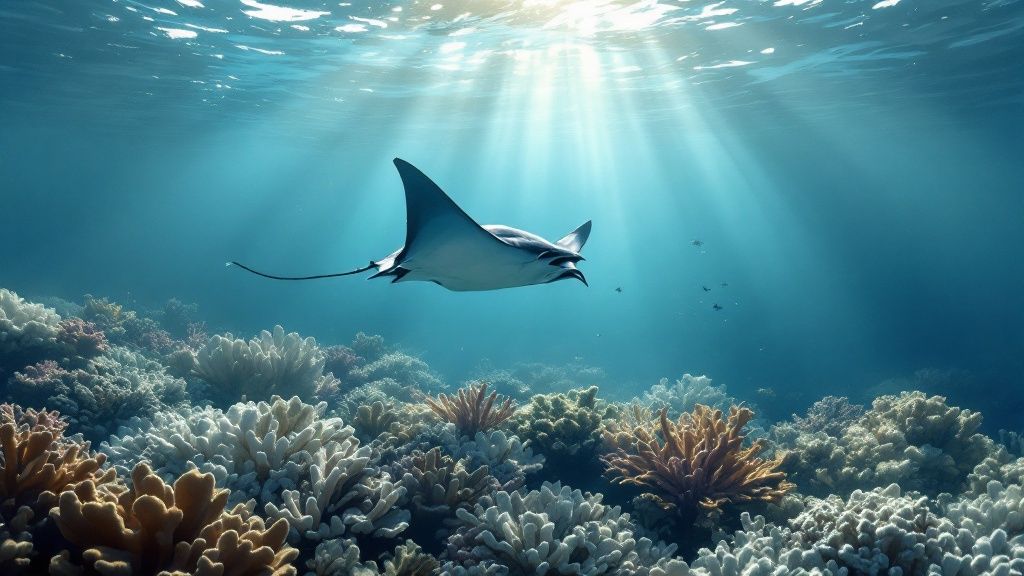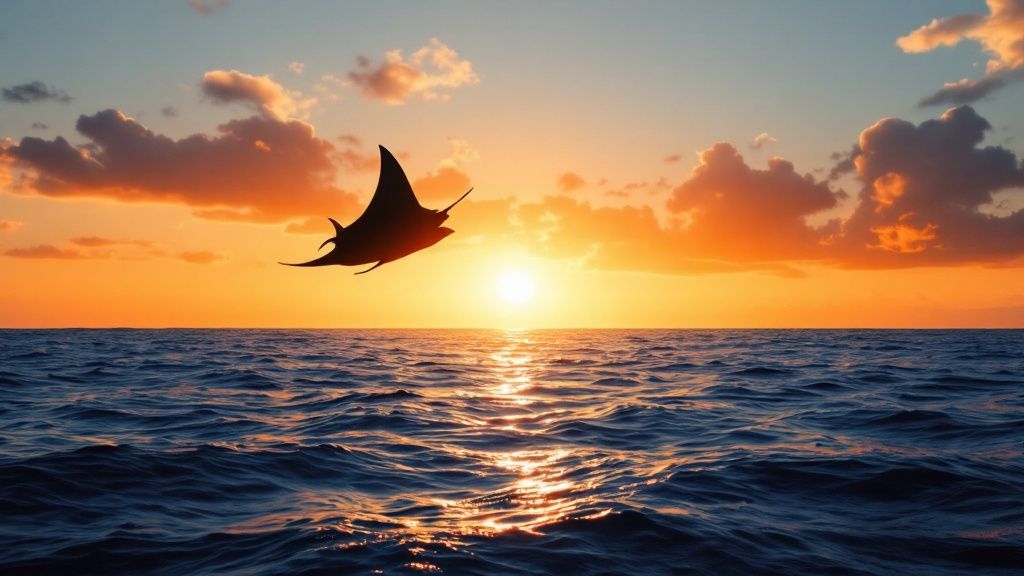Manta Rays Kona Big Island: Top Hawaii Dive Guide
- Byron
- Mar 13
- 10 min read
The Magic of Manta Rays Kona Big Island

The Kona coast of the Big Island is renowned for one of Hawaii's most captivating wildlife encounters: the manta ray night snorkel. These graceful creatures, with wingspans often exceeding 10 feet, create a mesmerizing ballet as they glide through the dark ocean waters. What makes this location such a haven for manta rays and a perfect viewing spot?
The answer lies in a combination of factors. The Kona coast’s unique underwater topography, featuring deep slopes and volcanic shelves, is key. This terrain creates ideal conditions for upwelling, bringing nutrient-rich water to the surface. This, in turn, sustains a thriving plankton population, the manta ray's primary food source. The typically calm waters and excellent visibility further enhance Kona's appeal as a premier manta ray viewing destination.
Manta rays are a major attraction on the Kona Coast, with a high probability of sightings. Between 2009 and 2014, meticulous records of manta ray sightings at 'Manta Village' and 'Manta Heaven' revealed consistent patterns in their behavior and habitat use. This data helped researchers understand the mantas' movements and predict peak viewing times. The Kona Coast stands out for its regular manta ray viewing opportunities, thanks to specific feeding sites where mantas gather to feast on plankton attracted by underwater lights. More detailed statistics can be found here: https://mantarayadvocates.com/manta-ray-statistics/
The Cultural Significance of Manta Rays
Beyond their biological significance, manta rays hold deep cultural importance in Hawaii. For generations, locals have revered these gentle giants, viewing them as symbols of wisdom, grace, and spiritual strength. Traditional stories and legends often depict mantas as guardians and messengers of the sea.
Kona's Unique Manta Ray Experience
Kona offers a truly unique experience: observing these majestic creatures feeding at night. Tour operators use specialized lights to attract plankton, drawing the manta rays closer to the surface. This provides an exceptional opportunity to witness their feeding behavior up close, whether snorkeling or diving. The predictability of these encounters, coupled with the easy access to viewing sites, makes Kona a truly exceptional destination for manta ray enthusiasts. The experience leaves a lasting impression, fostering a deeper appreciation for the ocean and its inhabitants.
Prime Viewing Locations Along Kona's Manta Coast
The Kona coast, specifically the area known as the "Manta Coast," offers several exceptional locations for manta ray viewing. These spots are chosen for their unique characteristics as ideal feeding grounds, attracting these gentle giants night after night. Understanding these locations helps you choose the experience best suited for you.
Manta Village (Keauhou Bay)
Keauhou Bay, home to "Manta Village," is perhaps the most well-known manta ray viewing spot. This sheltered bay boasts calm, clear waters, perfect for beginners and families. The shallow depth also contributes to excellent visibility. The bay floor’s topography, combined with underwater lights, creates a plankton-rich feeding zone that reliably attracts manta rays.
Manta Heaven (Garden Eel Cove)
Just north of Keauhou Bay lies "Manta Heaven," another popular viewing location near Garden Eel Cove. This spot is known for slightly deeper waters and more active manta rays. While accessible to snorkelers, Manta Heaven often presents more dynamic manta ray displays, appealing to those seeking a thrilling encounter. Manta ray sightings in Kona are remarkably consistent year-round, with no clear seasonal patterns. According to Kona Honu Divers, manta rays are seen on over 80% of nights at popular dive sites like 'Manta Ray Heaven' and 'Garden Eel Cove'. On average, about six manta rays are spotted per night, though some nights see many more, with records of over 36 mantas observed at once. This consistency makes Kona ideal for manta ray tourism.
Exploring Lesser-Known Gems
Beyond these two iconic locations, Kona has other manta ray viewing areas treasured by locals. These lesser-known spots can offer a more intimate experience, away from the crowds. While conditions and manta activity vary depending on ocean currents and plankton, these hidden gems offer a unique perspective on the manta rays' world. Different sites offer unique viewing experiences depending on ocean conditions, time of year, and manta ray behaviors.
To help you choose the right viewing spot, we've compiled a comparison of the main locations:
Manta Ray Viewing Sites Comparison
A detailed comparison of the main manta ray viewing locations on the Kona coast, including success rates, accessibility, and special features
Viewing Site | Location | Average Mantas/Night | Best For | Success Rate | Special Features |
|---|---|---|---|---|---|
Manta Village | Keauhou Bay | 6-10 | Beginners, families | High (80%+) | Calm, shallow water, excellent visibility |
Manta Heaven | Garden Eel Cove | 6-12+ | More experienced snorkelers/divers | High (80%+) | Deeper water, more dynamic manta activity |
Lesser-Known Sites | Varies | Varies | Those seeking a more private experience | Varies depending on conditions | Unique perspectives, away from crowds |
This table highlights the key differences between the main viewing locations, helping you decide which is best for your experience level and desired level of manta ray interaction. Manta Village offers a more predictable experience in calmer waters, while Manta Heaven provides the potential for more dynamic encounters. The lesser-known sites offer a unique perspective for those seeking a more private experience.
Choosing the Right Spot for You
Selecting the best viewing location depends on your comfort in the water, your snorkeling or diving experience, and your ambitions. Manta Village provides a calmer experience, while Manta Heaven offers a potentially more dynamic display in slightly deeper water. For more information, check out our blog post sitemap. Considering these factors helps you craft the perfect manta ray encounter, ensuring an unforgettable experience on Kona's Big Island.
The Secret Lives of Kona's Gentle Giants

Manta rays glide through Kona's waters, captivating observers with their elegance. But beneath the surface lies a world of fascinating adaptations that allow these gentle giants to thrive. From specialized feeding techniques to complex social structures, let's explore the secret lives of Kona's manta rays.
Identifying Individual Manta Rays
Researchers have discovered a clever way to track individual manta rays: their unique belly patterns. Like human fingerprints, these patterns allow scientists and guides to identify specific mantas. This method provides invaluable insights into their life histories, movement patterns, social interactions, and population dynamics.
Specialized Feeding Techniques
Kona's nutrient-rich waters provide a feast for manta rays, whose primary food source is plankton. These gentle giants have evolved specialized feeding techniques perfectly suited to this environment. Their large cephalic fins funnel plankton-rich water into their mouths. They also perform mesmerizing feeding loops, creating swirling vortexes that concentrate plankton for maximum feeding efficiency. The Kona Coast offers a front-row seat to observe these fascinating behaviors.
The Kona Coast is home to two manta ray species: the reef manta ray (Mobula alfredi) and the giant manta ray (Mobula birostris). The giant manta ray is the largest ray and one of the largest fish in the world, boasting wingspans reaching up to 26 feet. Despite their size, manta rays are intelligent and social. There's even evidence suggesting they possess self-awareness, recognizing themselves in mirrors. Approximately 130 manta rays regularly inhabit the waters around Hawaii's Big Island. Learn more about manta rays in Hawaii.
Social Structures and Movement Patterns
Tracking individual manta rays has revealed complex social structures within Kona's manta ray populations. Though generally solitary, they congregate at feeding sites, forming loose aggregations. These gatherings, sometimes referred to as manta ray ballets, provide researchers with opportunities to study their social dynamics and how these interactions influence their movements. Some mantas demonstrate site fidelity, returning to the same feeding grounds, while others roam more widely.
Conservation Efforts and Citizen Science
Protecting these majestic creatures requires collective effort. Ongoing conservation initiatives, including research and citizen science programs, are essential for safeguarding manta rays. Many tour operators participate in these efforts, collecting valuable data on manta ray sightings, behavior, and population trends. This data informs conservation strategies. Citizen scientists can contribute by reporting their own sightings, further expanding our knowledge. Participating in these programs is a rewarding way to contribute to the long-term survival of Kona's manta rays.
Dive or Snorkel: Crafting Your Perfect Manta Experience
Choosing between a dive and a snorkel for your manta ray encounter in Kona is a big decision. Both offer amazing views of these gentle giants, but the experiences are quite different. Understanding these differences will help you plan the perfect manta ray adventure on the Big Island.
Weighing Your Options: Dive vs. Snorkel
Several factors will influence your choice. Your comfort in the water, swimming skills, and preferred viewing angle all come into play. Certified instructors and marine guides often recommend considering these personal factors.
For example, strong swimmers comfortable in deeper water who want a truly immersive experience might prefer diving. If you’d rather a more relaxed approach with less equipment and simpler logistics, snorkeling offers an equally amazing experience.
The Diver’s Perspective: An Underwater Ballet
Divers get a three-dimensional view of the manta rays. They watch from below as the mantas glide through the water, observing their underwater ballet. This perspective allows for an intimate encounter, appreciating their agility and elegance. You'll witness their feeding techniques from a unique vantage point.
The Snorkeler’s View: A Spectacular Overhead Show
Snorkelers enjoy a spectacular overhead view. Floating on the surface, you’ll see the impressive wingspans of the mantas as they perform their feeding loops. This perspective highlights their size and grace. Snorkelers often see multiple mantas at once as they gather under the lights, creating a mesmerizing display.
To help you decide, here's a table comparing the two experiences:
Manta Ray Night Dive vs. Snorkel A comprehensive comparison of the two primary ways to experience manta rays on the Kona coast
Experience Type | Cost Range | Skill Required | Proximity to Mantas | Pros | Cons | Best For |
|---|---|---|---|---|---|---|
Snorkel | $100-$150 | Basic swimming ability | Closer to surface | Easier, less equipment, accessible to most | Less immersive, can be chilly | Families, beginners, those wanting a surface view |
Dive | $150-$250 | Certified diver | Closer overall, below and alongside | Immersive, 3D perspective | Requires PADI certification, more equipment | Experienced divers, those seeking close interaction |
This table summarizes key differences, such as cost, required skills, and manta proximity. Snorkeling is generally cheaper and only requires basic swimming skills, making it great for families and beginners. Diving, while needing certification, allows for closer interaction and a more immersive experience.
Each approach has its own advantages. Your perfect manta ray encounter on the Big Island awaits, whether you choose to dive into the depths or float amongst the stars. To learn more about manta ray tours in Kona, visit our pages sitemap.
Timing Your Manta Adventure For Maximum Success

The Kona coast of the Big Island offers amazing manta ray viewing year-round. However, understanding a few key elements can greatly improve your experience. With a bit of planning, you can maximize your chances of a truly memorable encounter.
Understanding Seasonal Influences
Seasonal weather patterns affect both water clarity and manta ray behavior. The calmer summer months (April-October) generally offer the best visibility. This is due to less rain and calmer seas. However, this is also the peak tourist season, so expect more crowded tours.
Winter (November-March) can bring rougher seas and occasional rain, sometimes affecting visibility. The benefit? Fewer crowds, which can lead to a more personal manta ray experience.
The Lunar Cycle's Impact
The lunar cycle plays a key role in plankton concentration. A full moon draws in more plankton, the main food source for manta rays. This often leads to increased feeding activity and exciting manta ray displays. Booking your trip around a full moon could increase your chances of seeing these mesmerizing feeding loops.
Interpreting Sighting Statistics
While manta rays are often sighted in Kona, it's important to be realistic. Their behavior is influenced by natural factors beyond our control. Understanding that sightings aren't a guarantee helps manage expectations and increases your appreciation for any encounter.
Finding Your Ideal Window
The best time for your manta ray adventure really depends on your individual preferences. Do you value clear water and dynamic displays, or a quieter experience with fewer people?
Perhaps calm conditions are your priority, or maybe your photography requires optimal lighting. Think about what’s important to you.
By considering these factors – seasonal conditions, lunar cycles, and visitor numbers – you can time your manta ray experience on Kona's Big Island for the best chance of success. This will help create a truly unforgettable memory.
Selecting An Ethical Manta Ray Tour Provider
Choosing the right manta ray tour operator is crucial for both your enjoyment and the well-being of these magnificent creatures in Kona. Not all tours prioritize ethical practices and manta ray conservation. It’s essential to find providers who value these gentle giants and their delicate ecosystem.
Recognizing Responsible Tour Operators
Responsible manta ray tour providers adhere to strict guidelines to minimize disturbances to the mantas and their environment. They prioritize education and conservation. For instance, responsible operators conduct detailed pre-trip briefings emphasizing respectful interaction with the mantas. They also follow in-water protocols, such as maintaining a safe distance and never touching the animals. You can learn more about ethical tour providers.
The Importance of The Manta Ray Green List
The Manta Ray Green List certification is a key indicator of a tour operator’s dedication to sustainable practices. This accreditation means they adhere to best practices, minimizing their environmental impact and prioritizing manta ray welfare. Choosing a Green List certified operator ensures your tour contributes to conservation, protecting these incredible animals for generations to come.
Asking The Right Questions
Before booking, ask potential operators specific questions about their practices. Inquire about their briefing procedures, in-water protocols, group sizes, and commitment to conservation. For example, ask about their interaction guidelines and how they minimize disturbance to the mantas. This shows your commitment to responsible tourism and helps you make an informed choice.
Warning Signs of Questionable Practices
Be wary of operators who encourage touching the mantas, overcrowd viewing areas, or operate in ways that visibly disturb the animals. These actions can stress the mantas and harm their delicate mucous layer, which is vital for their immune system. Prioritizing your convenience over the mantas’ well-being contributes to their decline. Choosing a responsible operator ensures a memorable experience and a positive impact on these gentle giants of Kona's Big Island.
Essential Preparation For Your Underwater Encounter

Turning your Kona Big Island manta ray experience into something truly extraordinary takes a little planning. Those who lead these tours daily offer helpful advice to elevate your underwater adventure.
Gear Up For Success
While most tour operators provide standard snorkel equipment, bringing your own mask and snorkel guarantees a comfortable, customized fit. A wetsuit is worth considering, particularly in the winter months, as even Hawaiian waters can get cool at night. A pool noodle can also be surprisingly useful. Many tours utilize these to help snorkelers grip the illuminated boards, conserving energy and maximizing viewing time.
Managing Nighttime Swimming Anxiety
The thought of swimming in the open ocean at night might be unsettling for some. Practicing deep, slow breathing and focusing on relaxation techniques can help ease these feelings. Remember, seasoned guides are present to assist you and ensure a safe trip. Many tours also offer flotation devices for additional security. For more information, you can check out our articles about Manta Ray experiences.
Seasickness Strategies And Comfort Tips
To minimize the chance of seasickness, think about taking motion sickness medication or using acupressure wristbands prior to your tour. A light meal is advisable beforehand – it's best to avoid anything heavy or greasy. Bringing a towel and dry clothes for the return boat trip will add to your comfort after snorkeling.
Maximizing Your Manta Ray Viewing
For the best views of the manta rays as they perform their elegant feeding loops, position yourself near, but not directly below, the light boards attracting plankton. Kona Big Island manta rays are well-known for these underwater ballets – a captivating spectacle you won't want to miss. Avoid making sudden movements, which can frighten the mantas. Instead, try to maintain a calm, still posture, allowing the manta rays to approach you for a truly unforgettable close-up encounter.
Book your unforgettable Manta Ray Night Snorkel Kona Hawaii Tours today! Click here to reserve your spot.
Comments